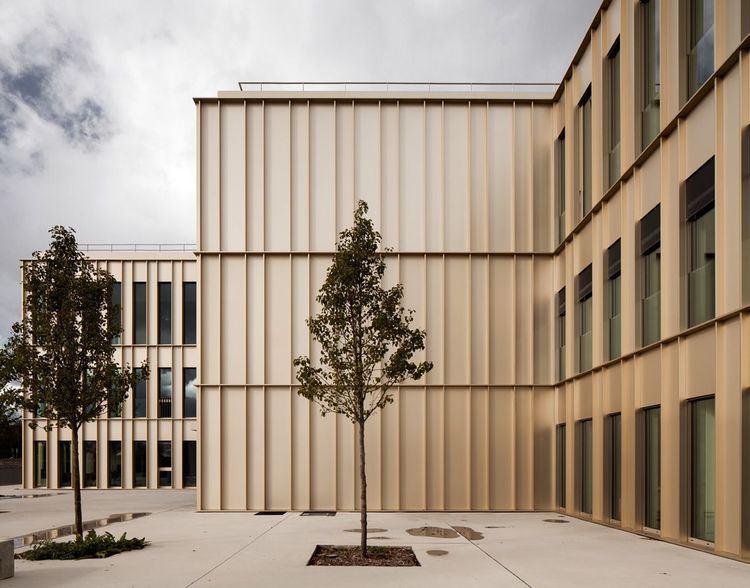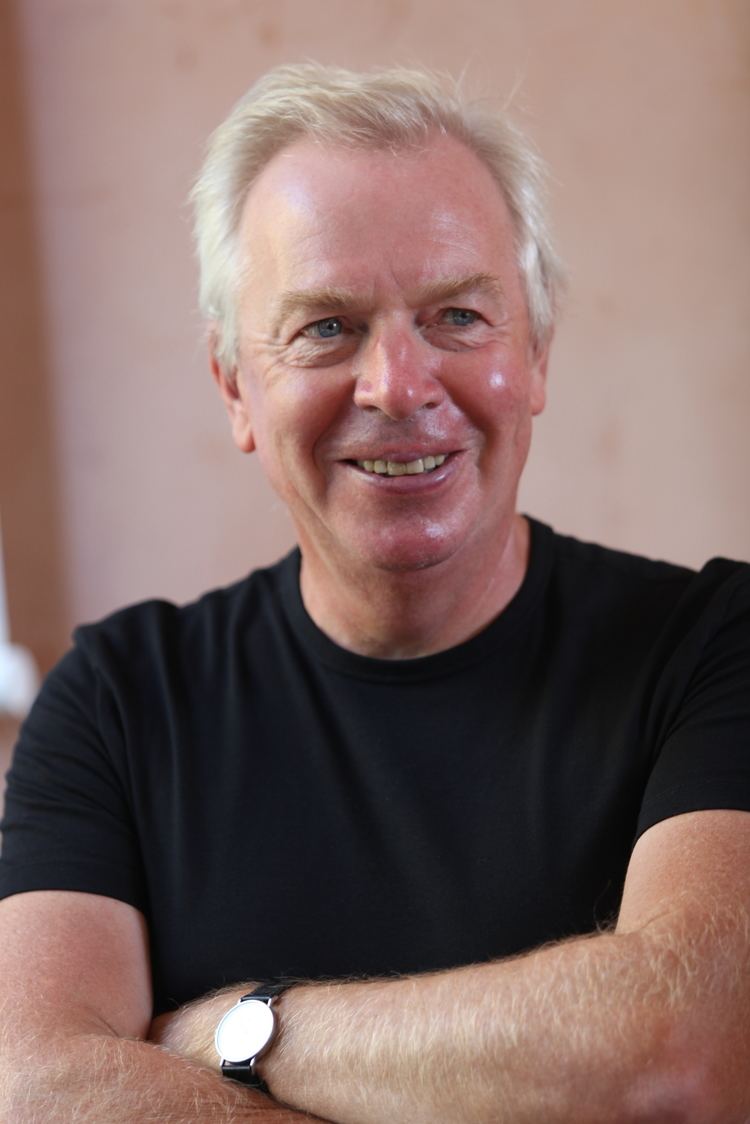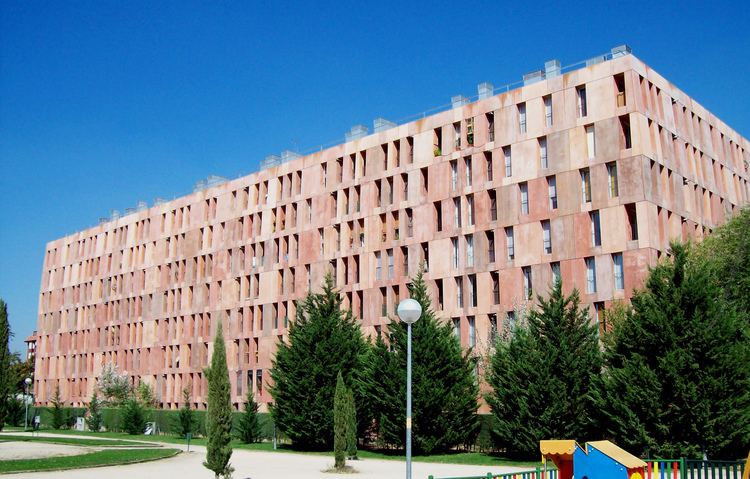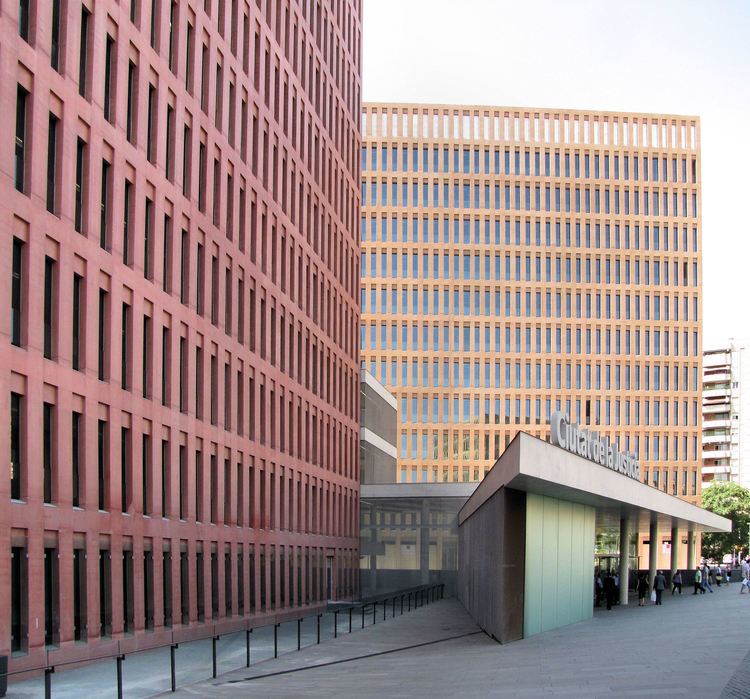Occupation Architect Name David Chipperfield | Role Architect | |
 | ||
Born 18 December 1953 (age 71) ( 1953-12-18 ) London, England Practice David Chipperfield Architects Projects Museum of Modern Literature, Marbach, Germany (2002–2006) America's Cup Building, Valencia, Spain (2005) Neues Museum, Museum Island Berlin (1997-2009)Museo Jumex, Mexico (2009-2013) Books David Chipperfield: Zusammenspiel, Architectural Presence: David Chipperfield Parents Alan John Chipperfield, Peggy Chipperfield Education Architectural Association School of Architecture, Kingston University Structures Museum of Modern Literature, America's Cup Building, James Simon Gallery, River and Rowing Museum, Saint Louis Art Museum Similar Kit Martin , John Frazer (architect), Richard Horden | ||
Tedxmarrakesh david chipperfield why does everyone hate modern architecture
Sir David Alan Chipperfield (born 18 December 1953) is an English architect. He established David Chipperfield Architects in 1985.
Contents
- Tedxmarrakesh david chipperfield why does everyone hate modern architecture
- David chipperfield a place to be architecture for art documentary
- Career
- River and Rowing Museum Henley on Thames UK 19891997
- Des Moines Public Library Des Moines Iowa 20022006
- Museum of Modern Literature Marbach Germany 20022006
- Americas Cup Building Veles e Vents Valencia Spain 200506
- The Neues Museum Berlin Germany 19972009
- The Hepworth Wakefield gallery 20032011
- City of Justice complex Barcelona Spain 20022011
- Saint Louis Art Museum expansion 20052013
- Turner Contemporary gallery Margate UK 20062013
- Coleccin Jumex Mexico City Mexico 20092013
- Style and philosophy
- Criticism
- Teaching
- Completed buildings in the UK selection
- Completed buildings outside the UK selection
- Ongoing work selection
- Awards and honours
- References

His major works include the River and Rowing Museum in Henley-on-Thames, Oxfordshire (1989–1998); the Museum of Modern Literature in Marbach, Germany; the Des Moines Public Library, Iowa (2002–2006); the Neues Museum, Berlin (1997–2009); The Hepworth Wakefield gallery in Wakefield, UK (2003–2011), the Saint Louis Art Museum, Missouri (2005–2013); and the Museo Jumex in Mexico City (2009–2013).

Rowan Moore, the architecture critic of the Guardian of London, described his work as serious, solid, not flamboyant or radical, but comfortable with the history and culture of its setting. "He deals in dignity, in gravitas, in memory and in art."

David Chipperfield Architects is a global architectural practice with offices in London, Berlin, Milan, and Shanghai.

David chipperfield a place to be architecture for art documentary
Career
Chipperfield was born in London in 1953, and graduated in 1976 from Kingston School of Art in London. He studied architecture at the Architectural Association (AA) in London, receiving his diploma in architecture in 1977. He worked in the offices of several notable architects, including Douglas Stephen, Norman Foster and Richard Rogers, before founding his own firm, David Chipperfield Architects, in 1985. As a young architect Chipperfield championed the historically-attuned, place-specific work of continental architects such as Moneo, Snozzi and Siza through the 9H Gallery situated in the front room of his London office.
He first established his reputation designing shops in London, Paris, Tokyo and New York.Among Chipperfield's early projects in England were a shop for Issey Miyake on London's Sloane Street in 1983, and a house for the fashion photographer Nick Knight in Richmond, Surrey. His shops in Japan led to commissions to design a private museum in the Chiba prefecture (1987), a design store for the automobile company Toyota in Kyoto (1989), and the headquarters of the Matsumoto Company in Okayama (1990). His firm opened an office in Tokyo in 1989.
His first completed projects in London were the gallery of botany and the entrance hall for the Museum of Natural History (1993), and restaurant Wagamama, both in London. His first major project in Britain was the River and Rowing Museum in Henley-on-Thames (1989) (see below). He also began to build in Germany, designing an office building in Dusseldorf (1994–1997). Other projects in the 1990s included the Circus Restaurant in London (1997) and the Joseph Menswear Shop (1997). The latter shop featured a curtain of glass six meters high around the two lower floors, and an austere modernist interior with dark gray sandstone floors and white walls.
In 1997 he began one his most important projects, the reconstruction and restoration of the Neues Museum in Berlin, which had been largely destroyed during World War II. After 2000, he won commissions for several other major museum projects in Germany, designed several major museum projects in Germany, including the Museum of Modern Literature in Marbach (2002–2006), and the Galerie Am Kupfergraben 10 in Berlin (2003–2007). In the same period he designed and built, at rapid speed, a new headquarters for the America's Cup in Valencia, Spain (2005–2006), and an enormous judicial complex in Barcelona, Spain, which consolidated the offices previously contained in seventeen different buildings into nine new immense concrete blocks. He also constructed his first project in the United States, an extension of the Museum of ethnology and natural history in Anchorage, Alaska (2003–2009).
Until 2011 most of his major projects were on the continent of Europe, but lin 2011 he opened two notable museum projects in Britain, the Turner Contemporary (2006–11) in Margate, and The Hepworth Wakefield in Wakefield. In 2013 he opened the Jumex Museum in Mexico City, and the extension of the Saint Louis Art Museum in the United States. His most remote project was the Museum of Naga, on a site in the desert 170 kilometers northeast of Khartoum in Sudan, a UNESCO World Heritage Site. He designed a structure to preserve the remains of two ancient temples and an artesian well, dating to 300 B.C.-300 A.D. The building, built of the local stone, blends into reddish mountains around it.
In 2015, Chipperfield won a competition to redesign the modern and contemporary art wing of the Metropolitan Museum in New York City. He also began his first ground-up building in New York City, the Bryant, a thirty-three story hotel and condominium project next to Bryant Park in Manhattan. In 2017 he and his associates were engaged in a multitude of major projects around the world; including new flagship stores for Bally and Valentino, the reconstruction of the U.S, Embassy in London; One Pancras Square, an office and commercial complex behind King's Cross Station in London.a project for the Shanghai Expo tower in China, the new Nobel Center headquarters for the Nobel Prize in Stockholm, a headquarters store for the online firm SSENSE in Montreal, the Kuntshaus cultural center in Zurich, the Haus der Kunst cultural center in Munich, the completion of the headquarters of Amorepacific in Seoul, Korea, and the Inagara Reien Project, a temple complex in Japan
River and Rowing Museum, Henley-on-Thames, UK (1989–1997)
The River and Rowing Museum in Henley-on-Thames is devoted particularly to the sports of rowing; the town hosted is home to the Annual Royal Regatta Olympic boating events in 1908 and 1948. The building is a blend of modernist and traditional forms and materials. It was inspired by the form of traditional boat sheds, as well as the traditional barns of Oxfordshire. The building occupies a space of 2300 square meters, and is lifted above the ground on concrete pillars to avoid flooding. The exterior and parts of the interior are covered in planks of non-treated oak, matching the local rural architecture. The roofs and sunscreens are of stainless steel,The entrance has glass walls, and the galleries on the ground floor receive natural light through roof.
Des Moines Public Library, Des Moines, Iowa (2002–2006)
The Des Moines Public Library in Des Moines, Iowa, covers an area of 110,000 square feet, and cost 32.3 million dollars to construct. The two-story building has no front or back; instead it fans out into three wings. a glass tunnel allows passers-by to stroll through the library. Its most distinct feature is an exterior of glass panels with cooper mesh sandwiched between them; the mesh blocks eighty percent of the sunlight, while allowing library patrons to gaze out at the park around the library. Chipperfield told Christopher Hall of the New York Times: "The architecture is neutral and amorphous; almost no architecture at all, and the copper mesh is an attempt to veil the building as much as possible while allowing the outside in."
Museum of Modern Literature, Marbach, Germany (2002–2006)
The Museum of Modern Literature is located in the town of Marbach, Germany, the birthplace of the poet Schiller. and benefits from a panoramic view of the Neckar River. It is located next to the beaux-arts building of the national Schiller Museum, built in 1903, and a more modern building of the German Literary Archives, from the 1970s. Visitors enter through a pavilion on the top floor and descend to the reading rooms below. While the lighting on the interior is entirely artificial, to protect the manuscripts, each level has a terrace overlooking the countryside. The facades of concrete, glass and wood are designed to give the impression of both solidity and modernity. The building was awarded the Stirling Prize in 2007.
America's Cup Building (Veles e Vents), Valencia, Spain (2005–06)
Chipperfield won a 2005 competition and construct a new headquarters for the America's Cup on the coast in Valencia, Spain. It was completed in just eleven months. The distinctive features of the 10,000 square meter building are three horizontal levels which overhang the terrace below by as much as fifteen meters, providing shade and an unobstructed view of the sea. The predominant color inside and out is white, with panels of white metal on the ceilings, floors of white resin, and exterior trim of white-painted stainless steel. Exterior accents are provided by planks of wood.
The Neues Museum, Berlin, Germany (1997–2009)
In 1997 Chipperfield, along with Julian Harrap, won a competition for the reconstruction of the Neues Museum in Berlin, which had been severely damaged during World War II. His commission was to recreate the original volume of the museum, both by restoring original spaces and adding new spaces which would respect the historic structure of the building. Reninforced concrete was used for new galleries and the new central staircase, while recycled bricks were used in other spaces, particularly in the north wing and the south dome. In addition, some of the scars of the war on the buildings walls were preserved, as an essential part of its history. As Chipperfield explained, the architects used these materials so that "The new would reflect that which was lost, without imitating it." The building received the European Union Prize for Contemporary Architecture in 2011. In 2007 Chipperfield began a new project with the museum, to construct a new gallery, the James Simon Gallery, inspired on the colonnade of the old museum. The new section will house more than ten thousand objects from the archeological collections, including the famed bust of Queen Nefertiti. It is scheduled for completion in 2017.
The Hepworth Wakefield gallery (2003–2011)
The Hepworth Wakefield is a gallery devoted to the work of the sculptor Barbara Hepworth. It is composed of ten trapezoidal blocks; its upper-level galleries are lit by natural light from large windows in the pitched roofs. Its windows have views of the river, historic waterfront and the city skyline. The building's façade is clad with self-compacting pigmented concrete made on site, the first of its kind in the United Kingdom. The architects selected the material to emphasise the gallery's sculptural appearance.
City of Justice complex, Barcelona, Spain (2002–2011)
The City of Justice is a group of nine buildings with 241,500 meters of space, which consolidate courtrooms and offices which previously were scattered among seventeen different buildings. The courtrooms are on the ground floor, with offices above. Four of the buildings are connected together by a four-story hallway. in addition to the judicial buildings, the complex, on the outskirts of Barcelona, includes a commercial center and retail stores, and a block of low income residential housing. The facades of the buildings are all the same, made of concrete poured in place and lightly tinted in different shades.Chipperfield wrote that the purpose of the building was to "break the image of justice as rigid and monolithic", but architectural critic Rowan Moore of the Guardian said it appeared "uncomfortably prison-like."
Saint Louis Art Museum expansion (2005–2013)
The Saint Louis Art Museum project in Saint Louis, Missouri (2005–2013) involved building a major new wing attached to a landmark of American architecture, the gallery built by beaux-arts architect Cass Gilbert in 1904. The new building by Chipperfield, with 9000 square meters of space, harmonizes smoothly with the classic building; its ground level is the same as that of the main floor of the Gilbert Building. The walls are dark concrete were poured and polished in place, and the roof of concrete caissons is designed to modify the light entering the galleries. To give the facade a distinctive look which also blended with the Gilbert building, Chipperfield speckled the dark gray polished concrete walls with fragments of the same kind of sandstone used in the Gilbert building. Edwin Heathcote of the Financial Times called it "a gem of clarity and deceptive simplicity...It is a building designed to glow, inside and out, one that is more about the intangibility of light than about mass reinforced by shadow."
Turner Contemporary gallery, Margate, UK (2006–2013)
The Turner Contemporary gallery is located beside a beach in Margate, to the north of Kent in the south of England. It is devoted to the works of J.M.W. Turner and his contemporaries, and those he influenced, and is close to the historic rooming house where the artist stayed. The museum is composed of six identical glass galleries, called "Cristalins", which are interconnected. The sunlight from the south is softened by a system of shutters over the ceiling, and the buildings are raised on pylons to avoid flooding from the neighboring sea. The fritted facades are designed to resist the dampness, corrosion and winds coming from the sea.
Colección Jumex, Mexico City, Mexico (2009–2013)
The Colección Jumex in Mexico City displays one of the largest private collections of contemporary art in Mexico, neighboring a theater and another museum in a modern neighborhood of the city. Zoning restrictions limited the space available, so Chipperfield put the museum administration, shop, and library in existing adjoining buildings, and devoted the Museum almost entirely to exhibit space. The galleries on the upper levels receive natural light from the skylights on the roof facing toward the west. The buiidling is supported on fourteen columns, and is built of concrete covered with plaques of travertine limestone from Xalapa, in Veracruz province. The floor-to-ceiling windows on the lower floors have frames of stainless steel.
Style and philosophy
Chipperfield's buildings cannot be described as following one particular style, although his work is sometimes seen as a reaction against the more flamboyant projects of Frank Gehry, Zaha Hadid or Santiago Calatrava. In 2005, he told Christopher Hall of the New York Times, "I'm very interested in doing buildings that people are fond of, but with each project I also try to push the boundaries, to make something familiar but different. I'm not so interested in convincing the architectural community that I'm a genius."
In a 2014 interview with Andy Butler in Designboom , Chipperfield declared: "The one thing you can't do in architecture, at least in my opinion, is to limit your way of thinking to a style, or a material, you have to be responsive to the circumstances of a project." He declared that "architecture could not be globalized", because it varied depending upon the culture of a city. "However contemporary we feel that we are, we still want to find different characteristics in different places. When we are building in a city we have a responsibility in a way to join in and to understand why buildings are as they are in that city. I find it very weak for an architect to disregard the history and culture of a city and say "I have an international style." There's absolutely no justification for that. It's the equivalent of having no variation in a cuisine, you may as well just place all the different types of food in a blender and consume it as a protein-rich shake."
Architecture critic Rowan Moore observed that "Chipperfield stresses less glamorous questions, such as, "how is a building going to look five or ten years later?" He quotes Chipperfiield on the his work on the Neues Museum, a project which lasted twelve years. "How you do things is profoundly important. the quality of the Neues museum construction is extraordinary even by German standards, and people can smell the quality. The concept would not have been so convincing without it."
Chipperfield described the style of his recent The Bryant residential tower in New York City (2013–2018) as "classical elegance in terms of its symmetries and simple grids and order." Describing the Bryant Park, Tim McKeough of the New York Times wrote "In contrast with other big-name architects who wow with audacious forms and breathtaking structural feats, Mr. Chipperfield is best-known for buildings with a pared-down aesthetic purity." He noted that Chipperfield's signature on the building was the facade, composed of precast terrazzo panels with a mosaic of marble and sandstone chips, polished to a matte finish, to give the building a distinctive reflective color.
Criticism
Rowan Moore of The Guardian reviewed the body of Chipperfield's work in a 2011 article. He was critical of some buildings, such as the Hepworth Gallery, which he suggested resembled "a bunker", and the law courts in Barcelona, which he said were "uncomfortably prison-like, as if defendants were guilty until proven innocent," but he also found much to admire in Chipperfield's work: "He is much sought after for projects that help define cities' modern view of themselves, often in relation to a rich or fraught history. He deals in dignity, in gravitas, in memory and art. He likes "permanence", "substance", and "meaning", and dislikes designs that are spectacular for the hell of it...His buildings have a strong presence, with right angles and straight lines prominent. He likes solid masonry and concrete, where you seed that stuff that is holding the building up, and sense its mass. he adheres, arguably too much, to the classical idea that architecture is about naked materials and structures seen in daylight. Mobility, surface, illusion, or the way artificial lighting forms cities at night, is less important to him...He likes the appearance and reality of permanence, and is skeptical about architect's common feeling that buildings can be as light and transient as airplanes or tents." He cites Chipperfield: "'You always have to dig a hold in the ground and pour a lot of concrete into it.'" Moore wrote: "What all these projects have in common is the desire to bring out the best in the thing that Chipperfield finds in the brief or site – the ruins in Berlin, the light in Margate, the art in Wakefield."
Teaching
Chipperfield has taught architecture in Europe and the United States, and has lectured extensively, including as Professor of Architecture at the Staatliche Akademie der Bildenden Künste, Stuttgart from 1995 to 2001. In addition Chipperfield held the Mies van der Rohe Chair at the Escola Técnica, in Barcelona, Spain, and the Norman R. Foster Professorship of Architectural Design at the Yale School of Architecture. He is a visiting professor at the University of the Arts London (formerly London Institute). He has been on the Board of Trustees of The Architecture Foundation and is currently a trustee of the Sir John Soane's Museum in London.
Completed buildings in the UK (selection)
Completed buildings outside the UK (selection)
Ongoing work (selection)
Awards and honours
The practice's projects have received more than 100 architecture and design awards, including the 2007 RIBA Stirling Prize (for the Museum of Modern Literature, Marbach), the 2011 European Union Prize for Contemporary Architecture (Mies van der Rohe Award), and the 2011 Deutscher Architekturpreis.
Chipperfield has been recognised for his work with honours and awards including membership of the Royal Academy of Arts, the Order of Merit of the Federal Republic of Germany, a knighthood for services to architecture, and the Praemium Imperiale from the Japan Art Association in 2013.
In 1999, Chipperfield was awarded the Tessenow Gold Medal, what was followed by a comprehensive exhibition of his work together with the work of the Tessenow Stipendiat and Spanish architect Andrés Jaque, held in the Hellerau Festspielhaus. In 2004 he was appointed Commander of the Order of the British Empire (CBE) for services to architecture, and was made Honorary Member of the Florence Academy of Art and Design in 2003. In 2009 he was awarded the Order of Merit of the Federal Republic of Germany, the highest tribute the Federal Republic of Germany can pay to individuals for services to the nation. In the New Year Honours 2010, Chipperfield was appointed as a Knight Bachelor for services to architecture in the UK and Germany. He was awarded the Wolf Prize in Arts in 2010 and the Royal Gold Medal of the Royal Institute of British Architects in 2011.
Form Matters, an exhibition looking back over Chipperfield's career, was mounted by London's Design Museum in 2009. His Tonale range of ceramics for Alessi received the Compassod'Oro in 2011, and the Piana folding chair has recently been acquired for the permanent collection at MoMA.
In 2012 Chipperfield became the first British architect to curate the Venice Biennale of Architecture. The biennale, entitled 'Common Ground', sought to foreground the collaborative and interconnected nature of architectural practice.
